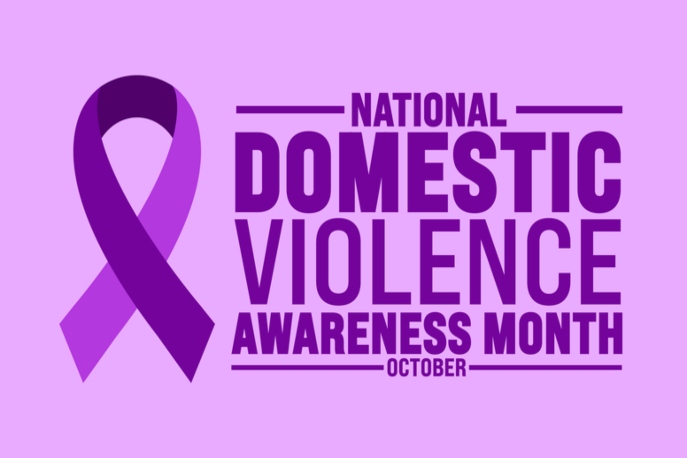Photo Credit: Neelrong28
Note: Both domestic violence and sexual violence are prevailing issues in our society that leave many feeling unsure of where they can turn to for safety. If you or someone you know needs help, please reach out to the National Domestic Violence Hotline or the National Sexual Assault Hotline for immediate assistance. We also encourage you to look through our directory of rape crisis centers to help you uncover the resources and services available in your area.
October is Domestic Violence Awareness Month. It is a time of year when advocates bring attention to the issue of domestic violence and the many forms of violence domestic abusers enact, which can include sexual violence. Yet, it is crucial that people do not regard the issues of domestic violence and sexual violence interchangeably. These forms of abuse have some areas of overlap, but they also have aspects that are distinct from one another. For this Domestic Violence Awareness Month, we will be discussing the distinctions and overlaps between domestic and sexual violence.
Broadly speaking, domestic violence is a form of abuse that occurs within a home environment between two people. Annually, 10 million people (one in four women and one in nine men) experience domestic violence in the United States. While we may think of domestic violence as just a phenomenon between intimate partners, the YWCA draws distinctions between intimate partner violence (IPV) and non-IPV. “Domestic Violence,” they say, “can occur between a parent and child, siblings, or even roommates. Intimate Partner Violence (IPV) can only occur between romantic partners who may or may not be living together in the same household.” As intimate partner dynamics have changed, legal definitions of domestic violence include people who either live partially together or not at all but have a current or previous history of a close relationship, which can include divorced/separated couples or couples who share a child. Domestic abuse is a broad umbrella that encompasses a variety of abusive behaviors, including physical abuse, emotional abuse, technological abuse, financial abuse, psychological abuse, spiritual abuse, and, yes, sexual abuse.
While sexual violence is one of the methods of abuse weaponized by domestic abusers against their targets, it is an action or set of behaviors that can happen within a wide array of settings, contexts, and relationships. The National Sexual Violence Resource Center (NSVRC) refers to sexual violence as, “any type of unwanted sexual contact. This includes words and actions of a sexual nature against a person’s will and without their consent.” Perpetrators of sexual violence can be in any kind of relationship to a victim, ranging from intimate partner to friend, family member, colleague, teacher, prison guard, faith leader, or even a stranger (though most perpetrators are known to the victim before the abuse). While sexual violence is an underreported crime, we know that 81% of women and 43% of men responded in a survey that they had experienced some form of sexual violence at some point in their lifetime. At large, many harmful sexual words, attitudes, and actions are normalized through rape culture, leaving many survivors doubting the validity of their emotions and memories or placing blame on themselves for what happened. RALIANCE recognized that understanding, defining, and processing the many types of sexual violence can be overwhelming and place undue burdens on survivors, which is why we developed our taxonomy for companies to better classify forms of sexual violence when receiving reports. Of course, we know that sexual violence extends beyond work settings to include areas like homes, schools, religious institutions, prisons, militaries, and even online spaces, which is why we know that the fight against sexual violence (as well as all forms of gender-based violence) requires participation from everyone in our communities.
Though these forms of abuse are distinct from one another, they also have some significant overlap. For example, we know that some communities are more likely to experience both domestic violence and sexual violence. Below are some resources that further dive into how members of varying minorities and other populations face risk towards both kinds of violence.
-Racial Minorities: Domestic Violence and Sexual Violence
-People with Disabilities: Domestic Violence and Sexual Violence
-Sexual Minorities: Domestic Violence and Sexual Violence
-Gender Minorities: Domestic Violence and Sexual Violence
-Pregnant People: Domestic Violence and Sexual Violence (During Pregnancy and Postpartum vs Rape Resulting in Pregnancy)
-Elders: Domestic Violence and Sexual Violence
-Minors: Domestic Violence and Sexual Violence
Additionally, we know that people who experience both domestic and sexual violence experience trauma, and this trauma manifests in mental, physical, and emotional consequences that can last a lifetime. Some of these symptoms can be intensified if they decide to pursue justice through the legal system, which many survivors describe as a retraumatizing process.
However, we also know that survivors of domestic and/or sexual violence have the capacity to stand tall. We know that they can be warriors and advocates who move mountains. In our field, we have seen how sexual violence survivors and domestic violence survivors are united in their mission to shape a safer, more equitable tomorrow. It is because of them that we know each and every survivor has the strength inside of them to move forward, control their own destiny, and make a true impact on anyone they choose to disclose to. This Domestic Violence Awareness Month, we hope our readers recognize that, while not all violence is the same, survivors of all types of violence should be understood and championed.
RALIANCE is a trusted adviser for organizations committed to building cultures that are safe, equitable, and respectful. RALIANCE offers unparalleled expertise in serving survivors of sexual harassment, misconduct, and abuse which drives our mission to help organizations across sectors create inclusive environments for all. For more information, please visit www.RALIANCE.org.

